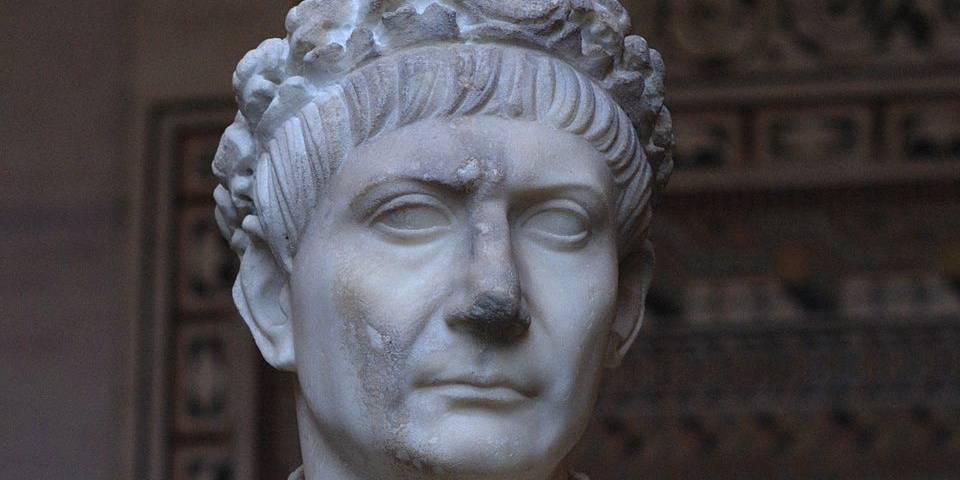

24915 views

Emperor Trajan or Imperator Caesar Nerva Traianus Divi Nervae Filius Augustus was a Roman Emperor from 98 AD to 117 AD. He was officially declared “optimus princeps,” which means “the best ruler,” by the Senate and remembered as a talented soldier and popular Emperor who influenced the greatest military expansion in Roman history. Moreover, he organized extensive public building programs and implemented social welfare policies.
Trajan has reputation as the second of the Five Good Emperors.
Contents
ToggleMarcus Ulpius Traianus was born in Italica, near Sevilla, an Italic settlement in Hispania Baetica, in 53 AD. He was the son of Marcia, a Roman noblewoman and sister-in-law of Emperor Titus. Marcus Ulpius Traianus, the elder, served Vespasian in the First Jewish-Roman War. In 76-77 AD, Trajan’s father was Governor of Syria.
He rose during the rule of Emperor Domitian. Trajan supported him against a revolt on the Rhine led by Antonius Saturninus while serving as a legatus legionis in Hispania Tarraconensis in 89 AD. Later, in 91 AD, Trajan created an ordinary Consul for the year. At the same time, he married Pompeia Plotina, a noblewoman from the Roman Settlement at Nimes. However, there were no children in this marriage.
When Nerva succeeded Domitian in 96 AD, the new Emperor became unpopular with the army. Moreover, he did not have children and had weak health since he was old. As a result, Emperor Nerva decided to adopt the more popular Trajan as his heir and successor. Thus, after only 15 months of rule, Trajan succeeded Nerva.
When Trajan became an emperor after the death of Nerva, he granted the plebs a gift of money. After that, however, the traditional donation to the troops became twice lower. Moreover, after Nerva’s death, Trajan did not return to Rome for some time because he inspected the Rhine and Danube frontiers to protect the Dacians. Finally, in 99 AD, he came back to Rome.
Trajan was popular for his bravery and simplicity of his habits.
As an emperor, he created a powerful domestic policy, restored the dilapidated road system, and built many new constructions like bridges, aqueducts, public baths, and a modern port of Ostia. However, one of the most significant tendencies of his rule was his incursion into the Senate’s remit, for example, his decision to turn the senate provinces of Achaia and Bithynia into imperial to cope with the excessive expenditures of local public magnates for public works and the generally poor management of provincial affairs by different proconsuls appointed by the Senate. Undoubtedly, Trajan had shared interests with the Senate. Also, he was an autocrat and a virtuous monarch.
Trajan was a senatorial Emperor, and he was inclined to choose his political support from among the representatives of the ruling urban oligarchies. For instance, in the West, there were families like his own, while in the East, there were families of Greek nobles. Here, the Greek nobility wanted from Rome the right to self-government. According to the historical facts, Trajan was a close friend of Dio of Prusa, and they engaged publicly in conversations with each other. Dio was an objective for one of the Emperor’s authoritarian innovations: the implementation of imperial correctors to audit the civic finances of the technically free Greek cities.
Trajan was popular among Roman citizens as an emperor, but his main passion was war. He ruled for 19 years, and during that period, he participated in three major wars: the first two with the Dacians and the last on the eastern frontier. During the reign of Domitian, Trajan was also involved with King Decebalus, but without any special consequences. Finally, in 101 AD, Trajan left Rome to battle with the Dacians and easily defeated them at Tapae. As a result, Decebalus was forced to cede a large piece of territory north of the Danube, but he did not respect the peace agreement.
Later, in 105 AD, Trajan returned to the north to fight the pesky Dacians again. Decebalus was defeated, and the Romans went to the Dacian capital of Sarmizegethusa, where the whole treasury was seized and sent back to Rome. Then, Decebalus committed suicide because he was in fear of being captured. Thus, the kingdom of Dacia became part of the Empire. However, over half a million people moved away from its territories, and Roman colonists moved there, creating the “Land of the Romans,” or today’s Romania.
When Trajan returned to Rome, his victories were celebrated by gladiatoral contests including more than 10.000 gladiators and about 11.000 animals
The Forum of Trajan and Trajan’s Column are two main symbols of memory that remained in Rome. The Forum of Trajan was financed by the seized Dacian treasury and was built in 112 AD. Moreover, the population of Rome during the reign of Nerva and then Trajan had raised to its greatest height, close to 10 million.
Thus, there was a need for a new forum where the first shopping mall – the Trajan’s Market and a center for politics, commerce, and religion were located. On the north side of the forum was a new basilica, Basilica Ulpias, which housed law courts. After the death of Trajan, Emperor Hadrian added a large gateway and a statue of Trajan riding a six-horse chariot.
The architect of the forum was Apollodorus of Damascus. He also designed Trajan’s Bridge across the Danube River. It was the longest bridge in the world until its destruction in 275 AD. In addition, Emperor Hadrian was exiled and later executed the architect. Later, in 113 AD, the Trajan’s Column was dedicated. The 34-meter column includes 2,500 images depicting the Emperor’s battles against the Dacians. Inside the column is a stairwell, which previously took people to a viewing platform. Today, there is a statue of Saint Peter on the top, while earlier, there was Trajan himself.
Read about Famous Architectural Columns in Rome.
At the beginning of 117 AD, Trajan grew ill. His health became worse, and he died from edema on August 8. Trajan was childless and adopted Hadrian as his successor. His reign was for 19 years, longer than anyone’s since Tiberius.
Author: Kate Zusmann
This website uses cookies. For more info read the cookies policy
Rome.us © 2026. Created with love by Roman experts and guides.